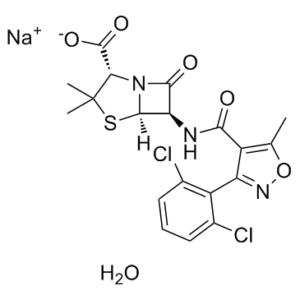This product is for research use only, not for human use. We do not sell to patients.

| Size | Price | Stock |
|---|---|---|
| 2g | $725 | To Be Confirmed |
| 5g | $1350 | To Be Confirmed |
| 10g | $2025 | To Be Confirmed |
Cat #: V5308 CAS #: 13412-64-1 Purity ≥ 98%
Description: Dicloxacillin Sodium is an orally bioactive, narrow-spectrum and semisynthetic isoxazolyl antistaphylococcal and narrow-spectrum β-Lactam antibiotic of the penicillin class, it is used to treat infections caused by susceptible Gram-positive bacteria, active against beta-lactamase-producing organisms such as Staphylococcus aureus.
Publications Citing InvivoChem Products
Product Promise

- Physicochemical and Storage Information
- Protocol
- Related Biological Data
- Stock Solution Preparation
- Quality Control Documentation
| Molecular Weight (MW) | 492.31 |
|---|---|
| Molecular Formula | C19H16Cl2N3NaO5S |
| CAS No. | 13412-64-1 |
| Storage | -20℃ for 3 years in powder formr |
| -80℃ for 2 years in solvent | |
| SMILES Code | O=C([C@@H](C(C)(C)S[C@]1([H])[C@@H]2NC(C3=C(C)ON=C3C4=C(Cl)C=CC=C4Cl)=O)N1C2=O)[O-].[H]O[H].[Na+] |
| Synonyms | Dicloxacillin sodium; BLP-1011; BRL-1702; P 1011; P-1011; P1011; MDI-PC |
| Protocol | In Vitro | Dicloxacillin exhibits EC50 values of 0.06 and 0.50 mg/L in ATCC 25923 and E19977, respectively. Dicloxacillin exhibits MIC values of 0.125 and 0.5 mg/L in ATCC 25923 and E19977 with pH 7.4, respectively. |
|---|---|---|
| In Vivo | Dicloxacillin exhibits therapeutic activity in murine peritonitis-sepsis model and all the mice are survivied. |
| Solvent volume to be added | Mass (the weight of a compound) | |||
|---|---|---|---|---|
| Mother liquor concentration | 1mg | 5mg | 10mg | 20mg |
| 1mM | 2.0312 mL | 10.1562 mL | 20.3124 mL | 40.6248 mL |
| 5mM | 0.4062 mL | 2.0312 mL | 4.0625 mL | 8.1250 mL |
| 10mM | 0.2031 mL | 1.0156 mL | 2.0312 mL | 4.0625 mL |
| 20mM | 0.1016 mL | 0.5078 mL | 1.0156 mL | 2.0312 mL |
This equation is commonly abbreviated as: C1 V1 = C2 V2
- (1) Please be sure that the solution is clear before the addition of next solvent. Dissolution methods like vortex, ultrasound or warming and heat may be used to aid dissolving.
- (2) Be sure to add the solvent(s) in order.




































